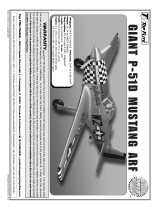Page is loading ...

Littlefoot Manual
Electric ARF Assembly Manual
Copyright 2015 EXTREME FLIGHT
Greetings and congratulations on your purchase of the Legacy Aviation
Littlefoot bushplane!
1

The Littlefoot is semi-scale homage to the great single-engine bushplanes that
fly around the world, and faithfully duplicates their performance. Super slow
spot landings, vertical takeoffs, one-wheel touch-and-goes, it does them all like
a true bushplane should. It also flies a variety of precision and 3D maneuvers
if you like, and will be a great companion for lazy circling around the field if
you don't.
Tips for Success:
1. Before starting assembly, take a few minutes to read the entire instruction
manual to familiarize yourself with the assembly process.
2. Use a fresh bottle of thin CA with a fine glue tip when attaching the CA
hinges. This will ensure that the proper amount of CA wicks into the hinge
2

and surrounding balsa wood and creates a proper bond between the wood and
hinges.
3. Take the time to properly balance and trim your aircraft and set up rates
and exponential values. Your flying experience will be greatly enhanced by
doing this.
Items needed for completion
-Hobby knife with #11 blades
-masking tape
-Thin and Medium CA.
-Blue Loctite.
-Small flat head and Phillips head screw drivers.
-Standard and needle nose pliers.
-Metric balldriver or allen key set.
-6 sub micro metal geared servos. All flight testing was performed with Hitec HS-65MG
and HS-5065MG digital servos and we strongly recommend the use of either of these high
quality servos.
-Torque 2814T/820 Brushless Outrunner motor.
-Airboss Elite 45 Amp ESC.
-4S 2100-2350 mah LiPo battery.
-APC 12x6 E prop (NOT the slow fly version!).
-40 mm Extreme Flight spinner.
-2 18"-24" extensions for the elevator and rudder servos and 2 12-18" extensions to go
between the receiver and the aileron servo leads, as well as 2 6-8" extensions for the flap
servos. We recommend the 28 or 32 AWG extensions to save weight.
-Adhesive backed Velcro and Velcro strap for battery retention.
3

Let's begin!
1. Locate the right and left wing panels. Using thin CA glue, apply several
drops to each hinge of the ailerons and flaps, flexing the ailerons and flaps to
make sure they move freely.
2. Locate the 2 G10 aileron control horns and 2 G10 flap control horns. Note
that they are different. Remove the covering over the servo openings in the
wing and the slots for the horns. Scuff the part of the horns that insert into
the surfaces with sandpaper and glue them in with medium CA glue.
4

FLAP.
AILERON.
5

3. Install the servos, using manufacturer-supplied hardware, for the ailerons
and flaps into the wings with the output shaft toward the rear.
4. Assemble the servo arms, servo arm connectors, and pushrods as shown.
The servo arm connectors must be able to rotate in their holes on the servo
arms. Use a drop of medium CA to retain the nut on the servo arm connector.
6

5. Install the servo arms and pushrods as shown
7

8

9

6. Locate the wing joiner brace. Using epoxy glue (to allow enough time
before drying for assembly), cover the brace in epoxy and join the two wing
halves permanently as shown. Use masking tape to hold the halves together
until the glue is dry.
10

7. Locate the elevators, horizontal stabilizer and vertical fin. Apply epoxy to
the bottom of the fin (to allow enough time to work before the glue dries) and
insert fully into the top of the fuselage.
Insert the elevators through the fuselage (TIP, flip the elevators upside down
and backwards before inserting, then turn them right-way-around). Slide the
horizontal stab into the fuselage.
Once you have the horizontal stab in place, slide the elevator with hinges in
place. Apply several drops of thin CA to the joint between the horizontal stab
and fuselage.
11

12

8. Using several drops of thin CA on each hinge, glue the elevator hinges. Flex the elevators
while gluing to be sure they move freely.
9. Insert the rudder into the vertical fin and glue hinges with then CA.
13

10. Install control horn into the elevators and rudder as shown, in the same
manner you installed horns into the wing surfaces.
Install servos and pushrods as shown.
14

15

11. Install tailwheel using wood screws into the fuselage, and a wood screw for
the tiller, as shown. Check to make sure the rudder swings freely.
16

12. Locate the landing gear, axles, axle nuts, wheels, and wheel pins.
Install axles onto landing gear and tighten.
17

13. Slide wheels onto axles and insert pins as shown.
14. Install landing gear onto fuselage and tighten screws. Note that the gear
sweeps slightly forward, not back.
18

15. Using medium CA, install the gear fairings onto the landing gear legs.
19

16. Install brushless motor onto firewall as shown using 4 x 3mm screws.
17. Use Velcro to affix ESC to bottom of motor box.
20
/


